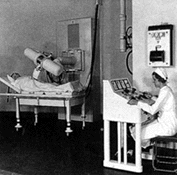Radiation therapy has been in use for the treatment of cancer and other diseases for approximately 100 years. As early as 1897, it was concluded that x-rays could be used for therapeutic as well as diagnostic purposes, and in 1912, Marie Curie published the "Theory of Radioactivity." The investigation of x-ray radiation for patient therapy moved into the clinical routine in the early 1920s.

An original x-ray cancer therapy
system in use circa 1922
Since the first uses of radiation to treat cancer, important changes have been made in the field and numerous developments have been accomplished, including:
- the generation of higher energy radiation beams for more effective cancer treatment
- the development of versatile linear accelerator and patient table designs to enable radiation to be delivered to the cancer from a variety of angles and directions
- the implementation of "multi-leaf" collimators (lead shutters) and other beam shaping devices for precision control and shaping of the radiation beam
- the use of CT, PET, MR and other image data sets to create three-dimensional planning models to accurately guide treatment
- the implementation of networked computers to track radiation treatment sessions and patient dose calculations (both planned and accumulated)
The ultimate goal of all of the above changes, developments, and improvements is the effective destruction of cancer tissue while delivering a minimal dose of radiation to adjacent healthy tissues. Another goal is to make the treatment easier and shorter for the patient to sustain and the physicians and other healthcare professionals to perform.
Updated: June 10, 2008



